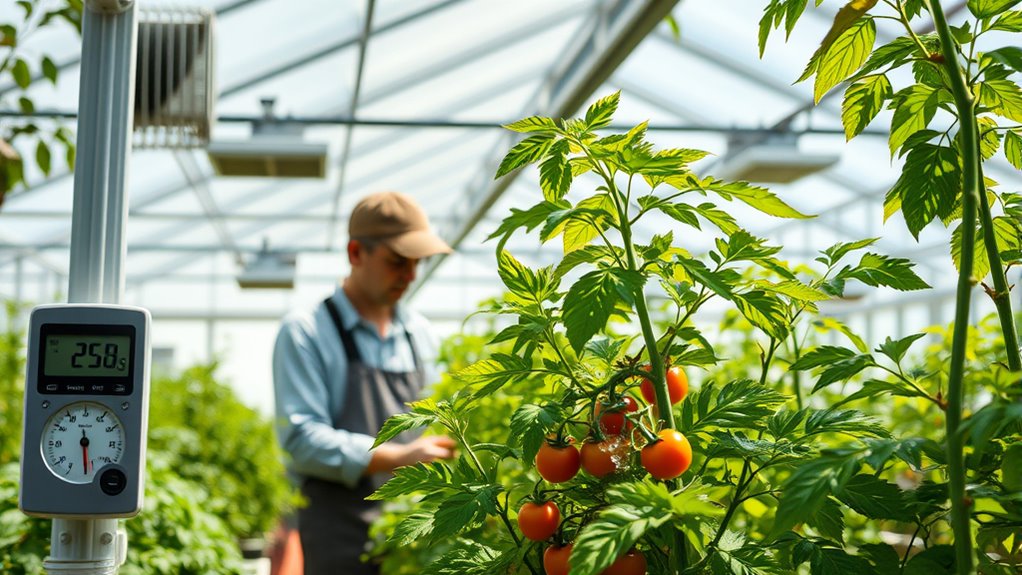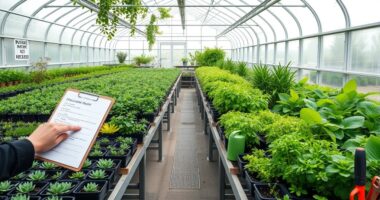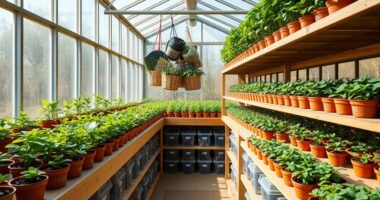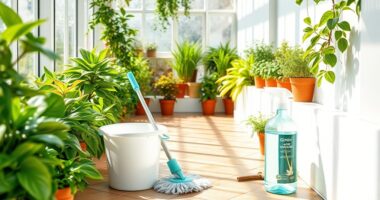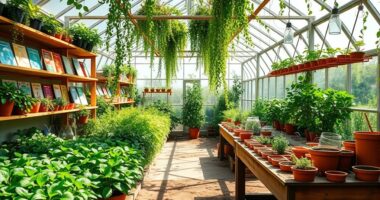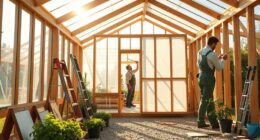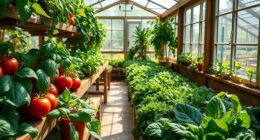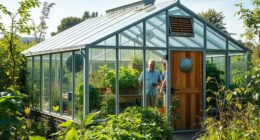To troubleshoot common greenhouse issues, regularly inspect plants for pests, diseases, and signs of stress. Keep environmental conditions stable by controlling temperature and humidity with fans, sensors, and proper ventilation. Prevent mold and mildew by ensuring good airflow and reducing moisture buildup. Adjust watering to match plant needs and improve drainage to avoid waterlogging. Ensuring proper light levels and nutrient balance is also key. If you want to learn more tips for a healthy greenhouse environment, keep exploring these strategies.
Key Takeaways
- Regularly inspect plants and environment for signs of pests, disease, or stress to enable early intervention.
- Maintain proper temperature, humidity, and air circulation using sensors and ventilation systems.
- Ensure adequate drainage and avoid overwatering to prevent root rot and mold growth.
- Keep greenhouse surfaces clean and sanitize tools to prevent pathogen spread.
- Adjust lighting and airflow to create optimal conditions and reduce humidity-related issues.
Identifying and Managing Pests and Diseases

How can you effectively spot pests and diseases early on? Regularly inspect your plants for signs like discolored leaves, holes, or sticky residue. Early detection is vital for quick action. Using plant health monitoring tools can help you identify issues before they become severe. Use companion planting to naturally deter pests; mixing herbs like basil or marigolds can repel insects while supporting plant health. Additionally, choose pest-resistant varieties when selecting plants—these are bred to resist common pests and reduce the need for chemical treatments. Keep an eye out for unusual growth patterns or spots that could indicate disease. Catching issues early allows you to isolate affected plants and prevent spread. Consistent monitoring, combined with strategic planting choices, helps you maintain a healthy greenhouse and minimizes pest and disease problems before they escalate. Recognizing garden pests early can also help you implement targeted control measures more effectively, especially by understanding how pests and diseases spread and thrive in controlled environments. Moreover, understanding the environmental conditions that favor pests and diseases can help you adjust your greenhouse management practices accordingly. Regularly updating your knowledge with current pest control methods can further enhance your ability to manage issues efficiently.
Controlling Temperature and Humidity Fluctuations
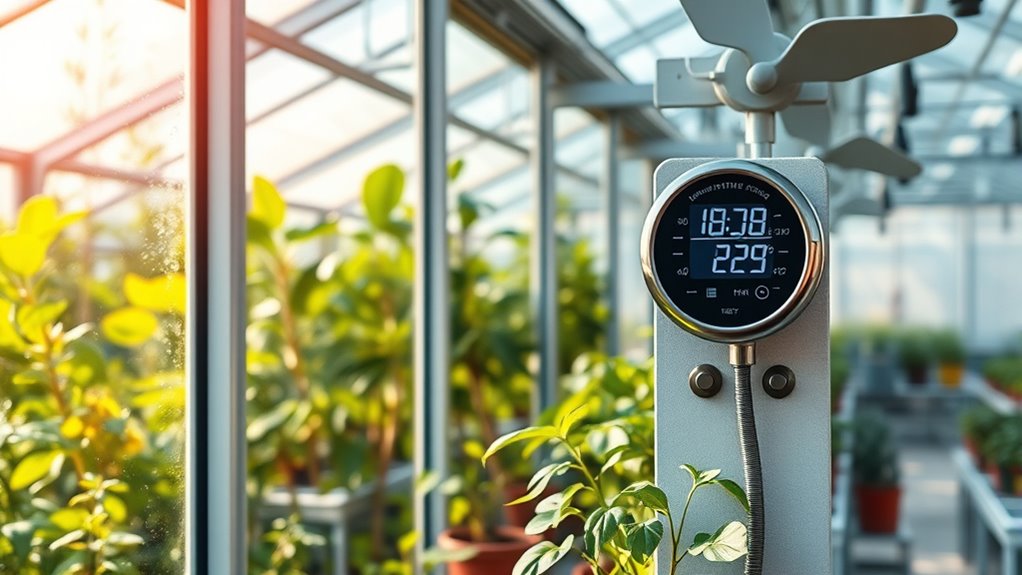
Maintaining stable temperature and humidity levels is essential for a healthy greenhouse environment. Proper temperature regulation ensures your plants don’t suffer from heat stress or cold damage, while effective humidity control prevents issues like mold or dehydration. To manage temperature fluctuations, use ventilation systems, exhaust fans, or shade cloths to cool the space during hot days. In cooler weather, consider heating options like space heaters or thermal mass to maintain warmth. For humidity control, use dehumidifiers or increase air circulation to reduce excess moisture. Conversely, add humidifiers if levels drop too low. Regularly monitor your greenhouse’s environment with reliable gauges, and adjust your systems accordingly. Additionally, understanding cookie categories can help optimize your greenhouse’s environmental controls if integrated with smart systems. Incorporating climate control systems can further automate and refine your environmental management, leading to healthier plant growth and easier maintenance. Proper environmental monitoring is vital for early detection of fluctuations and preventing potential problems before they escalate. Recognizing the importance of storage conditions can also help prevent issues like mold or spoilage in sensitive plants or materials. Using advanced sensors and automated systems can streamline this process and provide real-time data for better decision-making.
Preventing and Treating Mold and Mildew
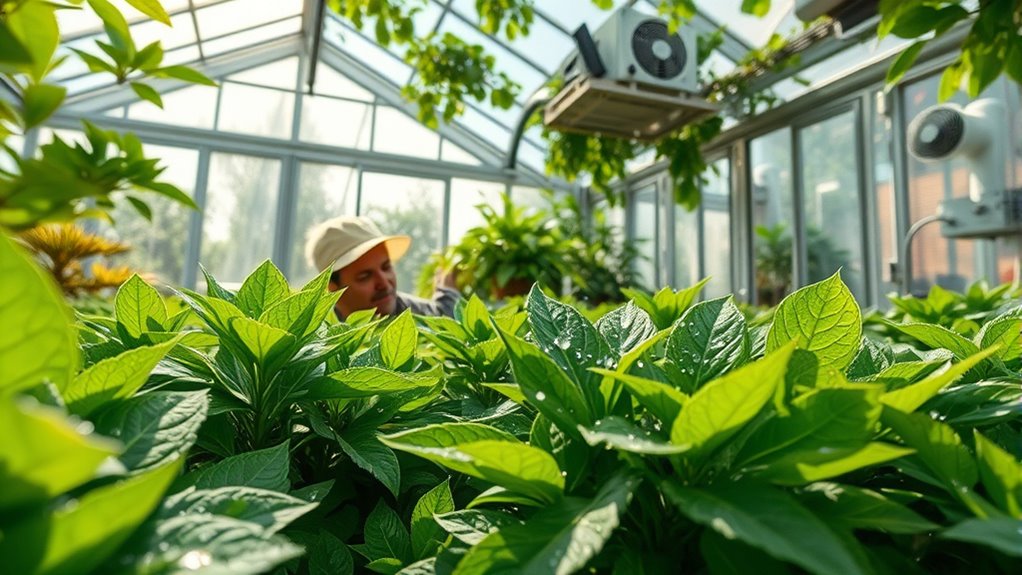
To prevent mold and mildew, you need to keep humidity levels in check and guarantee good air circulation. Regularly improve airflow and use preventative treatments to reduce the risk of fungal growth. These steps can keep your greenhouse healthier and free of troublesome mold issues. Incorporating easy homemade flautas into your routine can also promote a more balanced environment by encouraging proper ventilation and reducing excess moisture. Additionally, maintaining proper air purifier maintenance can help filter out airborne spores that contribute to mold development. Ensuring the use of eye patches with beneficial ingredients like collagen and hyaluronic acid can support overall health, indirectly aiding in creating an environment less conducive to fungal growth. Understanding greenhouse environment management is essential for long-term mold prevention and plant health. Moreover, implementing AI-driven solutions for monitoring humidity and airflow can optimize environmental control and early detection of mold risks.
Controlling Humidity Levels
Controlling humidity levels is essential for preventing mold and mildew in your greenhouse. Use humidity sensors to monitor moisture levels accurately, ensuring they stay within ideal ranges. Ulta Beauty Store Hours can provide insights into the best times to purchase equipment or supplies needed for humidity control. If humidity gets too high, consider installing misting systems that can temporarily lower moisture buildup by increasing air circulation and evaporation. Proper ventilation also plays a key role in maintaining balanced humidity and reducing excess moisture. Regularly check sensors and adjust misting systems as needed to prevent overly damp conditions that promote mold growth. Additionally, understanding optimal environmental conditions can help tailor humidity levels to suit specific plant needs and further reduce the risk of mold. Maintaining proper air filtration can also improve air quality and help control mold spores in the environment. Avoid overwatering plants, which can elevate humidity further. Maintaining environmental conditions helps create an environment less hospitable to mold and mildew.
Enhancing Air Circulation
Improving air circulation is one of the most effective ways to prevent and treat mold and mildew in your greenhouse. Proper airflow patterns help keep humidity levels consistent, reducing spots where mold can thrive.
Use circulation fans to move air evenly throughout the space, avoiding stagnant areas. Position fans to create gentle, cross breezes that enhance overall airflow without causing stress to plants.
Regularly check that fans are functioning properly and adjust their speed and placement as needed. Good circulation discourages moisture buildup on leaves and surfaces, which is essential for mold prevention.
Additionally, understanding self watering plant pots can help prevent overwatering, which contributes to high humidity levels conducive to mold growth. By maintaining ideal airflow, you create a healthier environment that minimizes the risk of mold and mildew spreading.
Consistent circulation is key to a cleaner, more resilient greenhouse.
Using Preventative Treatments
Implementing preventative treatments is essential for stopping mold and mildew before they take hold in your greenhouse. Start with soil sterilization to eliminate existing fungal spores and prevent future outbreaks. You can use heat treatment or organic options like solarization to reduce pathogen presence.
Additionally, applying seed treatments before planting helps protect seedlings from fungal infections early on. Choose fungicide-coated or treated seeds to boost resistance.
Maintaining proper humidity levels and ensuring good air circulation further supports these preventative steps. Regularly inspect plants for early signs of mold or mildew, and act swiftly if you notice any issues.
Addressing Watering and Drainage Issues
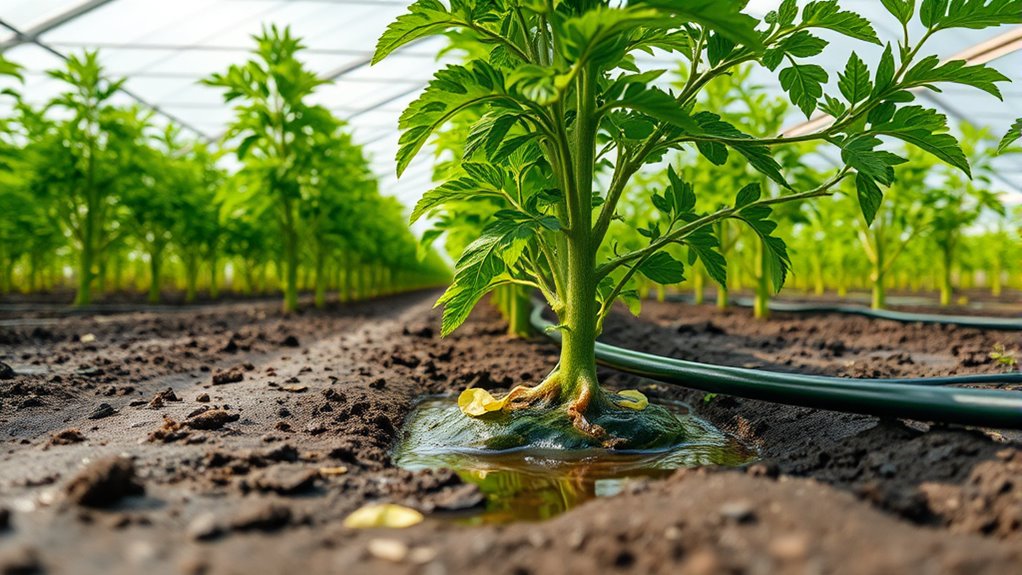
If your plants show signs of overwatering, such as yellowing leaves or root rot, it’s time to adjust your watering habits.
Ensuring proper drainage by using well-draining soil and installing drainage systems helps prevent excess water from sitting around roots.
Addressing these issues quickly keeps your greenhouse healthy and your plants thriving.
Overwatering Signs and Solutions
Overwatering is a common mistake that can quickly harm your greenhouse plants, leading to root rot, mold, and other health issues. To prevent this, pay attention to watering frequency; overwatering often occurs when you water too often or give excess water.
Signs of overwatering include yellowing leaves, soggy soil, and a foul smell. To fix this, ensure your plants aren’t sitting in water and allow the soil to dry out between watering sessions.
Proper drainage solutions, like using well-draining soil and pots with drainage holes, help prevent water from pooling. Adjust your watering schedule based on plant type, pot size, and environmental conditions.
Consistently monitoring soil moisture levels will help you avoid overwatering and keep your greenhouse plants healthy.
Proper Drainage Techniques
Proper drainage is essential for preventing water accumulation that can harm your greenhouse plants. To achieve this, focus on effective drainage system design, which includes using well-draining materials and ensuring proper slope in your floors and beds.
Incorporate drainage channels or pipes where necessary to direct excess water away from plant roots. Soil moisture management is also vital; amend your soil with organic matter or coarse sand to improve permeability.
Regularly check for signs of water pooling or overly saturated soil, and adjust your drainage setup accordingly. By optimizing your drainage system design and maintaining proper soil moisture levels, you can reduce the risk of root rot and other water-related issues, creating a healthier environment for your plants to thrive.
Ensuring Proper Light Levels and Ventilation
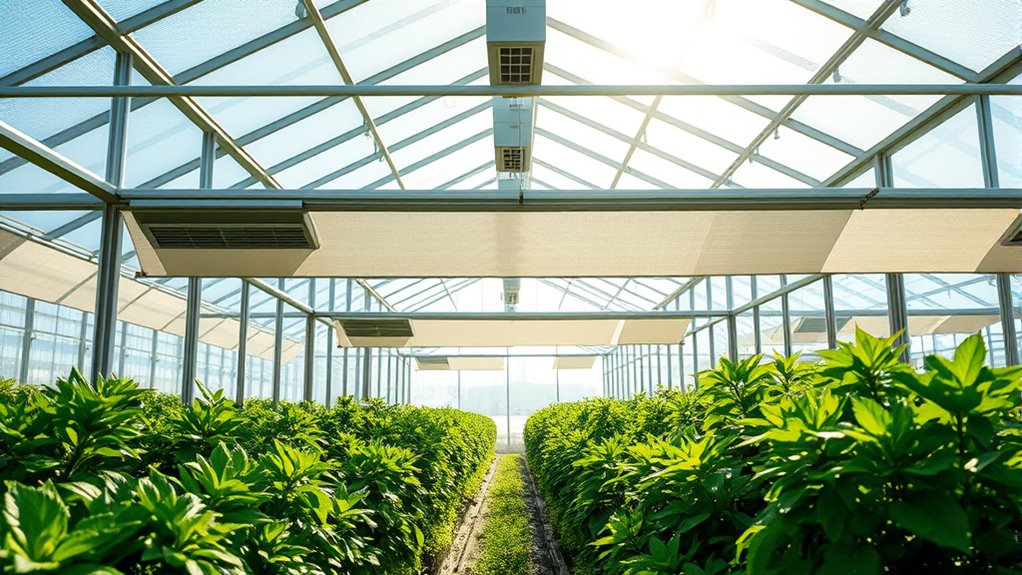
Maintaining the right light levels and ventilation is essential for a healthy greenhouse environment. Proper lighting schedules ensure plants receive adequate sunlight without overheating, while ventilation fans help regulate temperature and humidity. If either is neglected, your plants may wilt or become stressed. To visualize your efforts, consider this table:
| Brightness | Ventilation | Plant Health |
|---|---|---|
| Adequate | Properly used | Flourish |
| Insufficient | Overused | Wilting |
| Excessive | Underused | Stressed |
Optimizing these factors creates a balanced atmosphere where your plants thrive, and your greenhouse stays productive. Regularly adjust lighting and run ventilation fans as needed to maintain ideal conditions, ensuring your plants reach their full potential.
Troubleshooting Nutrient Deficiencies and Imbalances
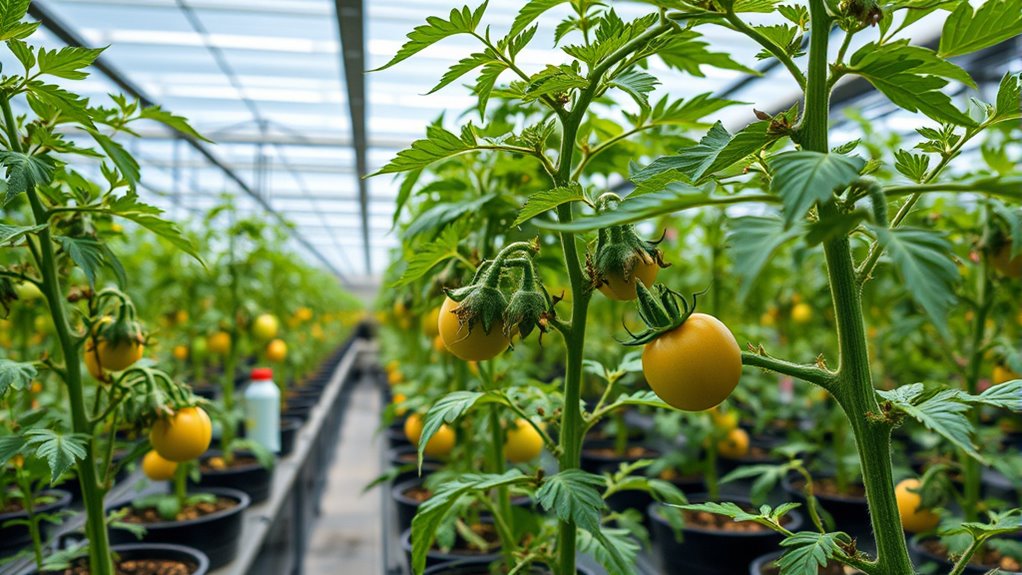
Nutrient deficiencies and imbalances are common issues that can hinder your plants’ growth if not addressed promptly. To identify problems early, perform regular nutrient testing of your soil. This helps you determine which nutrients are lacking or excessive.
Once you detect deficiencies, consider applying appropriate soil amendments—such as compost, mineral supplements, or organic fertilizers—to restore proper nutrient levels. Keep in mind that imbalances can cause symptoms like yellowing leaves, stunted growth, or poor flowering.
Address deficiencies with compost, mineral supplements, or organic fertilizers to restore healthy plant nutrients.
Adjust your feeding schedule based on test results and plant needs. Consistent monitoring and timely amendments ensure your greenhouse plants receive the right nutrients, promoting healthy growth and maximizing yields.
Staying proactive with soil testing and amendments is key to avoiding long-term nutrient issues.
Frequently Asked Questions
How Can I Detect Early Signs of Pest Infestations?
To detect early signs of pest infestations, you should focus on pest identification and early detection methods. Regularly inspect your plants, looking for tiny holes, discolored leaves, or webbing.
Keep an eye out for tiny insects or eggs on plant surfaces. By staying vigilant and monitoring your greenhouse consistently, you catch problems early, making pest control easier and preventing major damage.
Prompt detection helps maintain healthy, thriving plants.
What Are the Best Methods to Prevent Mold Growth?
Imagine walking into your greenhouse and noticing a damp, musty smell—mold could be lurking. To prevent mold growth, focus on mold prevention strategies like maintaining ideal humidity levels and ensuring good air circulation.
Proper air circulation keeps moisture moving, preventing it from settling and creating ideal conditions for mold. Regularly check for condensation and clean surfaces—these simple actions make a big difference in keeping your greenhouse mold-free.
How Do I Balance Humidity Without Affecting Temperature?
To balance humidity without impacting temperature, you should adjust your humidifier settings carefully, ensuring they match your plants’ needs. Use dew point management techniques to prevent excess moisture buildup, which can lead to mold.
Ventilate your greenhouse regularly to control humidity levels, and monitor temperature constantly to make sure it stays stable. This approach helps you maintain ideal conditions, promoting healthy plant growth without risking mold or temperature fluctuations.
What Are Common Causes of Poor Plant Growth Despite Proper Watering?
Think of your plants like a well-oiled machine; if they still struggle, something’s off. Poor growth despite proper watering often results from soil compaction or nutrient deficiency.
Soil compaction limits root growth, while lacking essential nutrients stunts development. Make certain you aerate the soil and provide balanced fertilization.
How Can I Optimize Light Distribution in a Small Greenhouse?
To optimize light distribution in your small greenhouse, focus on lighting optimization and shade management. Position grow lights strategically to guarantee even coverage, and use reflective surfaces to maximize natural light.
Install adjustable shading to control sunlight intensity during peak hours, preventing plant stress. Regularly monitor light levels with a light meter, and adjust shades or lights accordingly.
This approach ensures your plants receive consistent, adequate illumination for healthy growth.
Conclusion
Now that you know how to tackle common greenhouse problems, the key is staying vigilant. Imagine walking in one morning to find your plants thriving, or unexpectedly facing a new challenge. Will you catch the signs early or let issues escalate? Your attention and quick action can make all the difference. Keep troubleshooting, stay curious, and your greenhouse will remain a lush, vibrant haven—ready to surprise you at every turn.
